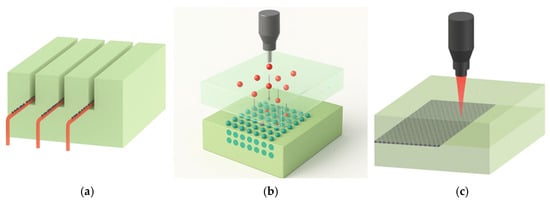-
 Hyperparameter Tuning of Artificial Neural Network-Based Machine Learning to Optimize Number of Hidden Layers and Neurons in Metal Forming
Hyperparameter Tuning of Artificial Neural Network-Based Machine Learning to Optimize Number of Hidden Layers and Neurons in Metal Forming -
 An Overview of the Working Conditions of Laser–Arc Hybrid Processes and Their Effects on Steel Plate Welding
An Overview of the Working Conditions of Laser–Arc Hybrid Processes and Their Effects on Steel Plate Welding -
 Lightweight and Sustainable Steering Knuckle via Topology Optimization and Rapid Investment Casting
Lightweight and Sustainable Steering Knuckle via Topology Optimization and Rapid Investment Casting
Journal Description
Journal of Manufacturing and Materials Processing
Journal of Manufacturing and Materials Processing
is an international, peer-reviewed, open access journal on the scientific fundamentals and engineering methodologies of manufacturing and materials processing published monthly online by MDPI.
- Open Access— free for readers, with article processing charges (APC) paid by authors or their institutions.
- High Visibility: indexed within Scopus, ESCI (Web of Science), Inspec, CAPlus / SciFinder, Ei Compendex and other databases.
- Journal Rank: JCR - Q2 (Engineering, Mechanical) / CiteScore - Q2 (Mechanical Engineering)
- Rapid Publication: manuscripts are peer-reviewed and a first decision is provided to authors approximately 16.2 days after submission; acceptance to publication is undertaken in 3.6 days (median values for papers published in this journal in the first half of 2025).
- Recognition of Reviewers: reviewers who provide timely, thorough peer-review reports receive vouchers entitling them to a discount on the APC of their next publication in any MDPI journal, in appreciation of the work done.
- Journal Cluster of Mechanical Manufacturing and Automation Control: Aerospace, Automation, Drones, Journal of Manufacturing and Materials Processing, Machines, Robotics and Technologies.
Impact Factor:
3.3 (2024);
5-Year Impact Factor:
3.6 (2024)
Latest Articles
Laser Processing Methods in Precision Silicon Carbide Wafer Exfoliation: A Review
J. Manuf. Mater. Process. 2026, 10(1), 2; https://doi.org/10.3390/jmmp10010002 - 19 Dec 2025
Abstract
►
Show Figures
The rapid advancement of high-performance electronics has intensified the demand for wide-bandgap semiconductor materials capable of operating under high-power and high-temperature conditions. Among these, silicon carbide (SiC) has emerged as a leading candidate due to its superior thermal conductivity, chemical stability, and mechanical
[...] Read more.
The rapid advancement of high-performance electronics has intensified the demand for wide-bandgap semiconductor materials capable of operating under high-power and high-temperature conditions. Among these, silicon carbide (SiC) has emerged as a leading candidate due to its superior thermal conductivity, chemical stability, and mechanical strength. However, the high cost and complexity of SiC wafer fabrication, particularly in slicing and exfoliation, remain significant barriers to its widespread adoption. Conventional methods such as wire sawing suffer from considerable kerf loss, surface damage, and residual stress, reducing material yield and compromising wafer quality. Additionally, techniques like smart-cut ion implantation, though capable of enabling thin-layer transfer, are limited by long thermal annealing durations and implantation-induced defects. To overcome these limitations, ultrafast laser-based processing methods, including laser slicing and stealth dicing (SD), have gained prominence as non-contact, high-precision alternatives for SiC wafer exfoliation. This review presents the current state of the art and recent advances in laser-based precision SiC wafer exfoliation processes. Laser slicing involves focusing femtosecond or picosecond pulses at a controlled depth parallel to the beam path, creating internal damage layers that facilitate kerf-free wafer separation. In contrast, stealth dicing employs laser-induced damage tracks perpendicular to the laser propagation direction for chip separation. These techniques significantly reduce material waste and enable precise control over wafer thickness. The review also reports that recent studies have further elucidated the mechanisms of laser–SiC interaction, revealing that femtosecond pulses offer high machining accuracy due to localized energy deposition, while picosecond lasers provide greater processing efficiency through multipoint refocusing but at the cost of increased amorphous defect formation. The review identifies multiphoton ionization, internal phase explosion, and thermal diffusion key phenomena that play critical roles in microcrack formation and structural modification during precision SiC wafer laser processing. Typical ultrafast-laser operating ranges include pulse durations from 120–450 fs (and up to 10 ps), pulse energies spanning 5–50 µJ, focal depths of 100–350 µm below the surface, scan speeds ranging from 0.05–10 mm/s, and track pitches commonly between 5–20 µm. In addition, the review provides quantitative anchors including representative wafer thicknesses (250–350 µm), typical laser-induced crack or modified-layer depths (10–40 µm and extending up to 400–488 µm for deep subsurface focusing), and slicing efficiencies derived from multi-layer scanning. The review concludes that these advancements, combined with ongoing progress in ultrafast laser technology, represent research opportunities and challenges in transformative shifts in SiC wafer fabrication, offering pathways to high-throughput, low-damage, and cost-effective production. This review highlights the comparative advantages of laser-based methods, identifies the research gaps, and outlines the challenges and opportunities for future research in laser processing for semiconductor applications.
Full article
Open AccessReview
A Review of Recent Advanced Applications in Smart Manufacturing Systems
by
Anastasiia Rozhok, Rosa Abate, Elena Manoli and Luigi Nele
J. Manuf. Mater. Process. 2026, 10(1), 1; https://doi.org/10.3390/jmmp10010001 - 19 Dec 2025
Abstract
►▼
Show Figures
Smart Manufacturing Systems (SMSs) have evolved into intelligent, data-driven ecosystems that integrate cyber–physical systems, digital twins, and artificial intelligence to enhance efficiency, sustainability, and resilience. This review synthesises more than 250 recent studies across four domains: manufacturing technologies, systems management, sustainable production, and
[...] Read more.
Smart Manufacturing Systems (SMSs) have evolved into intelligent, data-driven ecosystems that integrate cyber–physical systems, digital twins, and artificial intelligence to enhance efficiency, sustainability, and resilience. This review synthesises more than 250 recent studies across four domains: manufacturing technologies, systems management, sustainable production, and human–robot collaboration. In process optimisation, hybrid machine learning and genetic algorithms reduce surface roughness in machining by up to 35% and decrease energy use in additive manufacturing by 20–30%. In systems management, digital twins and reinforcement learning enable adaptive scheduling and predictive maintenance, increasing operational flexibility and reducing industrial downtime. Sustainability-oriented research shows that additive manufacturing can cut energy consumption by up to threefold compared with subtractive routes, while aluminium recycling and hot-forming processes lower life-cycle impacts. Furthermore, the integration of ISO 14001, ISO 50001, and ISO 14040 supports consistent environmental and energy performance assessment across sectors. Building on this evidence, the review critically examines recent developments in manufacturing technologies, systems management, sustainable practices, and human–robot collaboration, highlighting emerging paradigms such as explainable AI and human-centric design that strengthen safety, transparency, and resilience. Open challenges and research opportunities are outlined to guide future innovation toward intelligent, adaptive, and sustainable manufacturing systems.
Full article
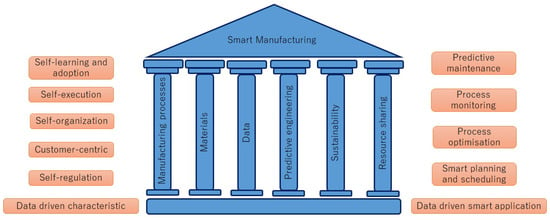
Figure 1
Open AccessArticle
Influence of Vibration-Assisted Dynamic Solidification on Microstructure and Mechanical Properties of Permanent Mold Cast Aluminum Alloy 2024 with Conformal Cooling
by
Muhammad Waqas Ali Khan, Rauf Ahmad, Syed Masood Arif Bukhari, Muhammad Sultan, Naveed Husnain, Muhammad Tuoqeer Anwar, Umer Bin Nooman, Hassan Raza, Abid Latif, Sajjad Ahmad and Khurram Hasnain Bukhari
J. Manuf. Mater. Process. 2025, 9(12), 416; https://doi.org/10.3390/jmmp9120416 - 18 Dec 2025
Abstract
►▼
Show Figures
Aluminum alloy 2024 (AA2024) is widely used in the aerospace sector, where a fine, uniform, and equiaxed grain structure is crucial for achieving enhanced mechanical properties. This study examines the effect of dynamic solidification, assisted by mechanical vibrations and conformal cooling, on the
[...] Read more.
Aluminum alloy 2024 (AA2024) is widely used in the aerospace sector, where a fine, uniform, and equiaxed grain structure is crucial for achieving enhanced mechanical properties. This study examines the effect of dynamic solidification, assisted by mechanical vibrations and conformal cooling, on the microstructural evolution and mechanical properties of permanent mold-cast AA2024. Mechanical vibrations were applied during solidification in the frequency range of 15–45 Hz and acceleration of 0.5–1.5 g. Process parameters, including pouring temperature, die temperature, vibration frequency, and acceleration, were optimized using an L9 orthogonal array based on the Taguchi method. Analysis of variance (ANOVA) was performed to determine the significance of the aforementioned process parameters. In addition, the alloy’s microstructure was observed through a microscope, which revealed a transition from dendritic to non-dendritic microstructure due to dynamic solidification. The average grain size of the alloy was significantly reduced by 40.9%. Moreover, the values of hardness and Ultimate Tensile Strength (UTS) of the alloy were improved by 13.5% and 10.6%, respectively. Optimal results were obtained at a pouring temperature of 750 °C, die temperature of 150 °C, frequency of 45 Hz, and acceleration of 1.0 g. Moreover, uncertainty analysis for all three responses was also performed.
Full article
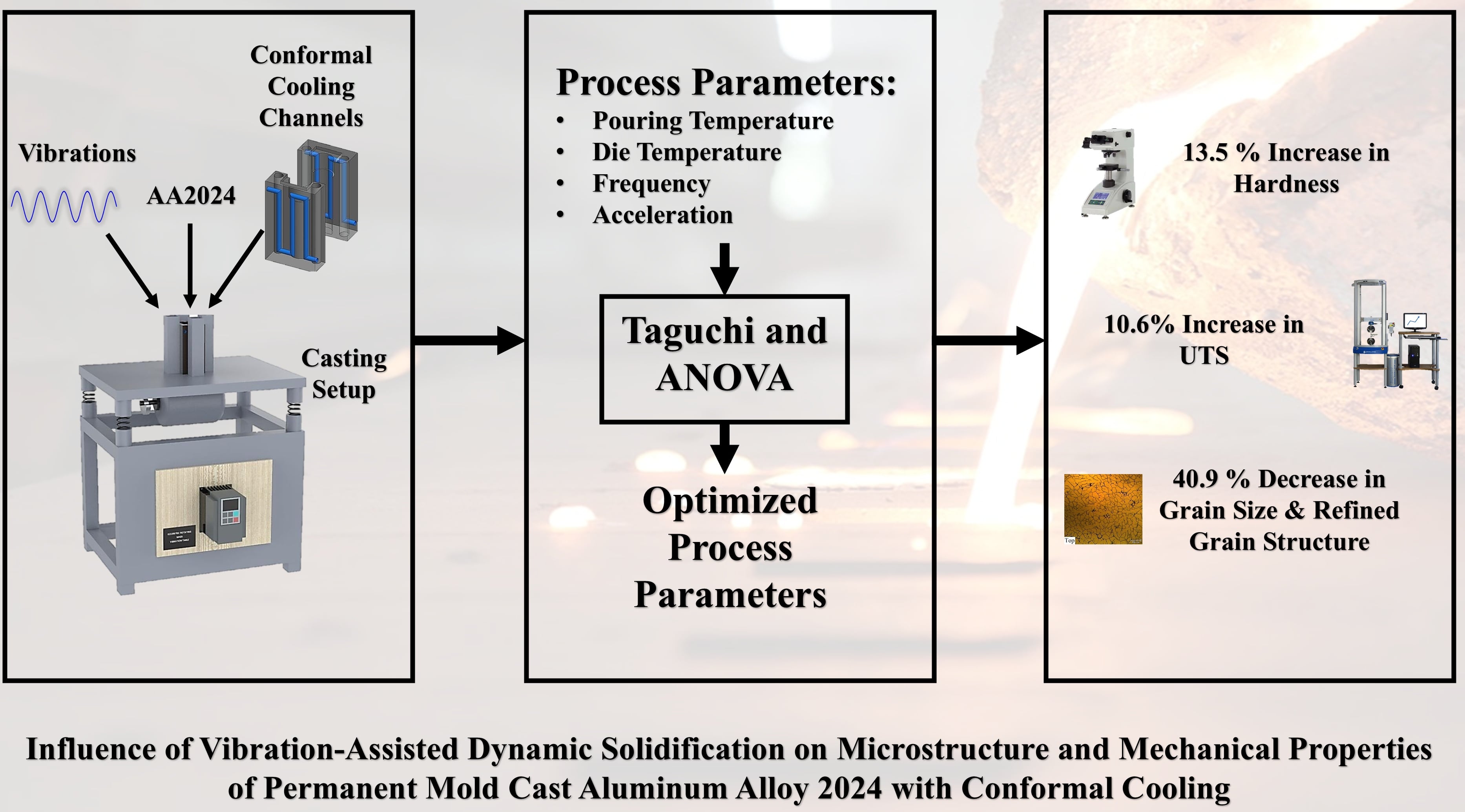
Graphical abstract
Open AccessArticle
Influence of Cutting Parameters and Tool Surface Texturing on Surface Integrity in Face Milling of AISI 1050 Carbon Steel
by
Serafino Caruso, Maria Rosaria Saffioti, Vincenzina Siciliani, Giulia Zaniboni, Domenico Umbrello, Leonardo Orazi and Luigino Filice
J. Manuf. Mater. Process. 2025, 9(12), 415; https://doi.org/10.3390/jmmp9120415 - 18 Dec 2025
Abstract
►▼
Show Figures
Machining of medium-carbon steels, such as AISI 1050, poses a significant challenge in terms of achieving stable cutting conditions, controlled chip evacuation and high surface integrity, in particular when full-face milling is performed under elevated material removal rates. The tool surface engineering approach,
[...] Read more.
Machining of medium-carbon steels, such as AISI 1050, poses a significant challenge in terms of achieving stable cutting conditions, controlled chip evacuation and high surface integrity, in particular when full-face milling is performed under elevated material removal rates. The tool surface engineering approach, particularly laser-induced micro-texturing, comprises a promising route toward modifying the tribological conditions at the tool–chip interface, thus affecting friction, heat generation, chip formation and the resultant surface finish. This study investigates the combined effects of cutting speed, axial depth of cut and tool micro-texture orientation (parallel versus orthogonal to the chip flow direction) on machining performance under wet conditions. In addition to the experimental analysis of cutting forces, chip morphology and surface roughness, this work integrates a full factorial Design of Experiments, regression modeling, and ANOVA to quantify the statistical significance of each factor and to identify dominant interactions. The regression models show strong predictive capability across all measured responses, while the ANOVA confirms the axial depth of cut and tool texture orientation as the most influential parameters. Multi-objective optimization by Pareto analysis further underlines the superiority of orthogonal micro-texturing, which consistently reduces the cutting forces and improves surface quality while promoting controlled chip segmentation. The results provide quantitative and statistically validated evidence of the enhancement of lubrication effectiveness, reduction in interface friction, and stabilization in chip formation provided by the micro-textured tools. Overall, the findings contribute to the development of data-driven machining strategies and surface-engineered cutting tools in view of improved productivity, energy efficiency and surface integrity in advanced manufacturing applications.
Full article

Figure 1
Open AccessArticle
Effect of MEX Process Parameters on the Mechanical Response of PLA Structures for Orthopedic Applications
by
Stelios Avraam, Demetris Photiou, Theodoros Leontiou and Loucas Papadakis
J. Manuf. Mater. Process. 2025, 9(12), 414; https://doi.org/10.3390/jmmp9120414 - 17 Dec 2025
Abstract
►▼
Show Figures
The advancement of polymeric materials for orthopedic applications has enabled the development of lightweight, adaptable structures that support patient-specific solutions. This study focuses on the design, fabrication, and mechanical characterization of additively manufactured (AM) polymeric polylactic acid (PLA) components produced via Material Extrusion
[...] Read more.
The advancement of polymeric materials for orthopedic applications has enabled the development of lightweight, adaptable structures that support patient-specific solutions. This study focuses on the design, fabrication, and mechanical characterization of additively manufactured (AM) polymeric polylactic acid (PLA) components produced via Material Extrusion (MEX), commonly known as Fused Filament Fabrication (FFF). By optimizing geometric configurations and process parameters, these structures demonstrate enhanced flexibility, energy absorption, and load distribution, making them well-suited for orthopedic products and assistive devices. A comprehensive mechanical testing campaign was conducted to evaluate the elasticity, ductility, and strength of FFF-fabricated samples under tensile and three-point bending loads. Key process parameters, including nozzle diameter, layer thickness, and printing orientation, were systematically varied, and their influence on mechanical performance was recorded. The results reveal that these parameters affect mechanical properties in a complex, interdependent manner. To better understand these relationships, an automated routine was developed to calculate the experimental mechanical response, specifically, stiffness and strength. This methodology enables an automated evaluation of the output, considering parameter ranges for future applications. The outcome of the analysis of variance (ANOVA) of the experimental investigation reveals that the printing orientation has a strong impact on the mechanical anisotropy in FFF, while layer thickness and nozzle diameter demonstrate moderate-to-weak importance. Thereafter, the experimental findings were applied on an innovative orthopedic wrist splint design to be fabricated by means of FFF. The most suitable mechanical properties were selected to test the mechanical response of the designed components under operational bending loading by means of linear elastic finite element (FE) analysis. The computational results indicated the importance of employing the actual mechanical properties derived from the applied printing process parameters compared to data sheet values. Hereby, an additional parameter to adjust the mechanical response is the product’s design topology. Finally, this framework lays the foundation for future training of neural networks to optimize specific mechanical responses, reducing reliance on conventional trial-and-error processes and improving the balance between orthopedic product quality and manufacturing efficiency.
Full article
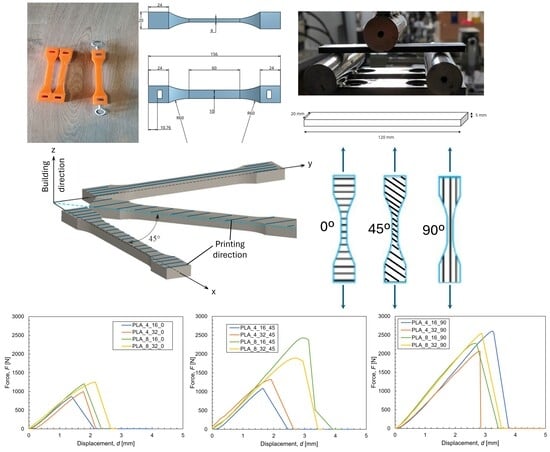
Graphical abstract
Open AccessArticle
Mechanism Governing the Effect of Roller Straightening of a Pure Magnesium Strip on the Tensile Stress–Strain Curve Shape
by
Stanislav O. Rogachev, Viacheslav E. Bazhenov, Eugene S. Statnik, Vladimir A. Andreev, Anatoly E. Shelest and Nikita A. Ershov
J. Manuf. Mater. Process. 2025, 9(12), 413; https://doi.org/10.3390/jmmp9120413 - 17 Dec 2025
Abstract
►▼
Show Figures
A roller straightening process of a pure magnesium strip, accompanied by alternating elastic-plastic deformation, was performed through one and three passes, where one pass corresponded to 19 bending events. It was discovered that roller straightening leads to the appearance of a kink in
[...] Read more.
A roller straightening process of a pure magnesium strip, accompanied by alternating elastic-plastic deformation, was performed through one and three passes, where one pass corresponded to 19 bending events. It was discovered that roller straightening leads to the appearance of a kink in the specimen’s tensile stress–strain curve as well as an almost twofold decrease in the yield stress. This effect was observed only on longitudinal specimens. The conducted EBSD analysis confirmed the previously stated hypothesis about the influence of twinning on the change in the shape of the roller-straightened magnesium alloy specimen’s stress–strain curve. The tensile twins {

Figure 1
Open AccessReview
Fundamentals of Cooling Rate and Its Thermodynamic Interactions in Material Extrusion
by
Ahmad Saeed Alzahrani, Muhammad Khan and Feiyang He
J. Manuf. Mater. Process. 2025, 9(12), 412; https://doi.org/10.3390/jmmp9120412 - 16 Dec 2025
Abstract
►▼
Show Figures
Material Extrusion (ME) is a layer-by-layer additive manufacturing technique that has gained prominence due to its simplicity, cost-effectiveness, design freedom, and adaptability to a wide range of thermoplastic materials. However, the mechanical performance of ME-printed parts often remains suboptimal, primarily due to complex
[...] Read more.
Material Extrusion (ME) is a layer-by-layer additive manufacturing technique that has gained prominence due to its simplicity, cost-effectiveness, design freedom, and adaptability to a wide range of thermoplastic materials. However, the mechanical performance of ME-printed parts often remains suboptimal, primarily due to complex thermal phenomena that govern microstructural development during the printing process, which are key determinants of mechanical strength. As a result, optimizing thermodynamic printing parameters has become essential for improving the overall quality of the printed parts. Extensive research articles and reviews have been published to explore the effect of many ME printing parameter settings on the resultant product characteristics. Despite this focus, the effect of cooling rate, a critical thermodynamic parameter of the process, has been largely overlooked in current research when they are critically reviewed. Cooling rate plays a central role in determining the thermal history of printed material, which in turn influences polymer chain mobility and microstructural features of the extruded material, all of which are crucial to the mechanical integrity of the printed part. Thus, it has been concluded by this review that analytical and empirical investigations into the influence of cooling rate on the microstructural properties of ME parts represent a valuable and novel contribution to the academic field.
Full article

Figure 1
Open AccessArticle
Enhancing Geometric Deviation Prediction in Laser Powder Bed Fusion with Varied Process Parameters Using Conditional Generative Adversarial Networks
by
Subigyamani Bhandari, Himal Sapkota and Sangjin Jung
J. Manuf. Mater. Process. 2025, 9(12), 411; https://doi.org/10.3390/jmmp9120411 - 15 Dec 2025
Abstract
The progress in metal additive manufacturing (AM) technology has enabled the printing of parts with intricate geometries. Predicting and reducing geometrical deviations (i.e., the difference between the printed part and the design) in metal AM parts remains a challenge. This work explores how
[...] Read more.
The progress in metal additive manufacturing (AM) technology has enabled the printing of parts with intricate geometries. Predicting and reducing geometrical deviations (i.e., the difference between the printed part and the design) in metal AM parts remains a challenge. This work explores how changes in laser speed, laser power, and hatch spacing affect geometrical deviations in parts made using laser powder bed fusion (L-PBF) and emphasizes predicting geometrical defects in AM parts. Sliced images obtained from CAD designs and printed parts are utilized to capture the effects of various L-PBF process parameters and to generate a comprehensive data set. Conditional Generative Adversarial Networks (cGANs) are trained to predict images that accurately reflect actual geometrical deviations. In this study, the influence of L-PBF process parameters on geometric deviation is quantified, and the prediction results demonstrate the effectiveness of the proposed cGAN-based method in improving the predictability of geometric deviations in parts fabricated via L-PBF. This approach is expected to facilitate early correction of geometrical deviations during the L-PBF process.
Full article
(This article belongs to the Special Issue Smart Manufacturing in the Era of Industry 4.0, 2nd Edition)
►▼
Show Figures

Figure 1
Open AccessArticle
Deep Neural Network-Based Inverse Identification of the Mechanical Behavior of Anisotropic Tubes
by
Zied Ktari, Pedro Prates and Ali Khalfallah
J. Manuf. Mater. Process. 2025, 9(12), 410; https://doi.org/10.3390/jmmp9120410 - 14 Dec 2025
Abstract
Tube hydroforming is a versatile forming process widely used in lightweight structural applications, where accurate characterization of the hoop mechanical behavior is crucial for reliable design and simulation. The ring hoop tensile test (RHTT) provides valuable experimental data for evaluating the elastoplastic response
[...] Read more.
Tube hydroforming is a versatile forming process widely used in lightweight structural applications, where accurate characterization of the hoop mechanical behavior is crucial for reliable design and simulation. The ring hoop tensile test (RHTT) provides valuable experimental data for evaluating the elastoplastic response of anisotropic tubes in the hoop direction, but frictional effects often distort the measured force–displacement response. This study proposes a deep learning-based inverse identification framework to accurately recover the true hoop stress–strain behavior from RHTT data. Convolutional and recurrent neural network architectures, including CNN, long short term memory (LSTM), gated recurrent unit (GRU), bidirectional GRU (BiGRU), bidirectional LSTM (BiLSTM) and ConvLSTM, were trained using numerically generated datasets from finite element simulations. Data augmentation and hyperparameter tuning were applied to generalization. The hybrid ConvLSTM model achieved superior performance, with a minimum mean absolute error (MAE) of 0.08 and a coefficient of determination (R2) value of approximately 0.97, providing a close match to the Hill48 yield criterion. The proposed approach demonstrates the potential of deep neural networks as an efficient and accurate alternative to traditional inverse methods for characterizing anisotropic tubular materials.
Full article
(This article belongs to the Special Issue Innovative Approaches in Metal Forming and Joining Technologies)
►▼
Show Figures
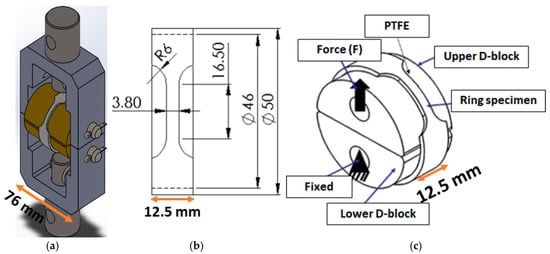
Figure 1
Open AccessArticle
Induction-Heated, Unrestricted-Rotation Rectangular-Slot Hot End for FFF
by
Miguel Rodríguez, David Blanco, Juan Antonio Martín, Pedro José Villegas, Alejandro Fernández and Pablo Zapico
J. Manuf. Mater. Process. 2025, 9(12), 409; https://doi.org/10.3390/jmmp9120409 - 13 Dec 2025
Abstract
►▼
Show Figures
This work presents a fused-filament fabrication (FFF) hot end that combines an unrestricted-rotation C-axis with a rectangular-slot nozzle and an induction-heated melt sleeve. The architecture replaces the popular resistive cartridge and heater block design with an external coil that induces eddy-current heating in
[...] Read more.
This work presents a fused-filament fabrication (FFF) hot end that combines an unrestricted-rotation C-axis with a rectangular-slot nozzle and an induction-heated melt sleeve. The architecture replaces the popular resistive cartridge and heater block design with an external coil that induces eddy-current heating in a thin-walled sleeve, threaded to the heat break and nozzle, reducing thermal mass and eliminating wired sensors across the rotating interface. A contactless infrared thermometer targets the nozzle tip; the temperature is regulated by frequency-modulating the inverter around resonance, yielding stable control. The hot end incorporates an LPBF-manufactured nozzle, which transitions from a circular inlet to a rectangular outlet to deposit broad, low-profile strands at constant layer height while preserving lateral resolution. The concept is validated on a desktop Cartesian platform retrofitted to coordinate yaw with XY motion. A twin-printer testbed compares the proposed hot end against a stock cartridge-heated system under matched materials and environments. With PLA, the induction-heated, rotating hot end enables printing at 170 °C with defect-free flow and delivers substantial reductions in job time (22–49%) and energy per part (9–39%). These results indicate that the proposed approach is a viable route to higher-throughput, lower-specific-energy material extrusion.
Full article

Figure 1
Open AccessArticle
Novel Development of FDM-Based Wrist Hybrid Splint Using Numerical Computation Enhanced with Material and Damage Model
by
Loucas Papadakis, Stelios Avraam, Muhammad Zulhilmi Mohd Izhar, Keval Priapratama Prajadhiana, Yupiter H. P. Manurung and Demetris Photiou
J. Manuf. Mater. Process. 2025, 9(12), 408; https://doi.org/10.3390/jmmp9120408 - 12 Dec 2025
Abstract
►▼
Show Figures
Additive manufacturing has increasingly become a transformative approach in the design and fabrication of personalized medical devices, offering improved adaptability, reduced production time, and enhanced patient-specific functionality. Within this framework, simulation-driven design plays a critical role in ensuring the structural reliability and performance
[...] Read more.
Additive manufacturing has increasingly become a transformative approach in the design and fabrication of personalized medical devices, offering improved adaptability, reduced production time, and enhanced patient-specific functionality. Within this framework, simulation-driven design plays a critical role in ensuring the structural reliability and performance of orthopedic supports before fabrication. This research study delineates the novel development of a wrist hybrid splint (WHS) which has a simulation-based design and was additively manufactured using fused deposition modeling (FDM). The primary material selected for this purpose was polylactic acid (PLA), recognized for its biocompatibility and structural integrity in medical applications. Prior to the commencement of the actual FDM process, an extensive pre-analysis was imperative, involving the application of nonlinear numerical models aiming at replicating the mechanical response of the WHS in respect to different deposition configurations. The methodology encompassed the evaluation of a sophisticated material model incorporating a damage mechanism which was grounded in experimental data derived from meticulous tensile and three-point bending testing of samples with varying FDM process parameters, namely nozzle diameter, layer thickness, and deposition orientation. The integration of custom subroutines with utility routines was coded with a particular emphasis on maximum stress thresholds to ensure the fidelity and reliability of the simulation outputs on small scale samples in terms of their elasticity and strength. After the formulation and validation of these computational models, a comprehensive simulation of a full-scale, finite element (FE) model of two WHS design variations was conducted, the results of which were aligned with the stringent requirements set forth by the product specifications, ensuring comfortable and safe usage. Based on the results of this study, the final force comparison between the numerical simulation and experimental measurements demonstrated a discrepancy of less than 2%. This high level of agreement highlights the accuracy of the employed methodologies and validates the effectiveness of the WHS simulation and fabrication approach. The research also concludes with a strong affirmation of the material model with a damage mechanism, substantiating its applicability and effectiveness in future manufacturing of the WHS, as well as other orthopedic support devices through an appropriate selection of FDM parameters.
Full article

Figure 1
Open AccessReview
Artificial Intelligence in Biomedical 3D Printing: Mapping the Evidence
by
Maria Tănase, Cristina Veres and Dan-Alexandru Szabo
J. Manuf. Mater. Process. 2025, 9(12), 407; https://doi.org/10.3390/jmmp9120407 - 11 Dec 2025
Abstract
This study provides an integrated synthesis of Artificial Intelligence (AI) applications in Biomedical 3D Printing, mapping the conceptual and structural evolution of this rapidly emerging field. The bibliometric analysis, based on 229 publications indexed in the Web of Science Core Collection (2018–2025) and
[...] Read more.
This study provides an integrated synthesis of Artificial Intelligence (AI) applications in Biomedical 3D Printing, mapping the conceptual and structural evolution of this rapidly emerging field. The bibliometric analysis, based on 229 publications indexed in the Web of Science Core Collection (2018–2025) and visualised in CiteSpace, identifies three interconnected research domains: AI-driven design and process optimisation, data-assisted bioprinting for tissue engineering, and the development of smart and adaptive materials enabling 4D functionalities. The results highlight a clear progression from algorithmic control of additive manufacturing parameters toward predictive modelling, deep learning, and autonomous fabrication systems. Leading contributors include China, India, and the USA, while journals such as Applied Sciences, Polymers, and Advanced Materials act as major dissemination platforms. Emerging clusters around “4D printing”, “deep learning”, and “shape memory polymers” indicate a shift toward intelligent, sustainable, and personalised biomanufacturing. In addition, a qualitative synthesis of the most influential papers complements the bibliometric mapping, providing interpretative depth on the scientific core driving this interdisciplinary evolution. Overall, the study reveals the consolidation of a multidisciplinary research ecosystem in which computational intelligence and biomedical engineering converge to advance the next generation of adaptive medical fabrication technologies.
Full article
(This article belongs to the Special Issue Advances in 3D Printing Technologies: Materials, Processes, and Applications)
►▼
Show Figures

Figure 1
Open AccessArticle
Statistical Correlation Analysis of Surface Roughness of Micromilled 316L Stainless Steel Components Fabricated by FDM–FFF Hybrid Manufacturing
by
Ali Dinc, Suleiman Obeidat, Ali Mamedov, Murat Otkur and Kaushik Nag
J. Manuf. Mater. Process. 2025, 9(12), 406; https://doi.org/10.3390/jmmp9120406 - 10 Dec 2025
Abstract
This study evaluates the surface roughness of micromilled 316L stainless steel parts fabricated via fused filament fabrication (FFF) and sintering, establishing statistical links between additive manufacturing and post-machining parameters. The surface roughness of the final part is affected by both 3D printing and
[...] Read more.
This study evaluates the surface roughness of micromilled 316L stainless steel parts fabricated via fused filament fabrication (FFF) and sintering, establishing statistical links between additive manufacturing and post-machining parameters. The surface roughness of the final part is affected by both 3D printing and micromachining parameters. The presented work has direct practical relevance because micromilled 316L stainless steel components are frequently used in applications such as lab-on-a-chip (LOC) devices and micro-electro-mechanical systems (MEMS), where fatigue behavior and the rheological behavior of fluid flow play critical roles. Both fluid flow and fatigue performance of micromilled components are highly dependent on surface integrity, including surface roughness, residual stresses, and microstructure. Specimens were produced using a 3D printer, under controlled layer thicknesses, raster angles, and fabrication directions, followed by a sintering process for the 3D-printed parts. The sintered parts are then micromilled at varying cutting directions (Angle Cut). Surface roughness (Ra) was measured with a profilometer, generating 34 experimental datasets analyzed through correlation and regression modeling. Cutting direction (Angle Cut) exhibited the strongest positive correlation with Ra (r = 0.486, p = 0.004), followed by layer thickness (r = 0.326, p = 0.060), whereas raster angle and fabrication direction had minimal influence. The multiple linear regression model accounted for 33.5% of Ra variance (R2 = 0.335, p = 0.0158), highlighting that fine-layer deposition and alignment of tool paths with filament orientation significantly improve post-machined surface quality. Results confirm that additive-induced anisotropy persists after sintering, affecting chip formation and surface morphology during micromilling. The novelty of this work lies in its integrated hybrid framework, linking metal FFF process parameters, fabrication direction, and machining outcomes through a unified statistical approach. This foundation supports machine-learning-based prediction and hybrid process optimization in metal FFF systems, providing guidance for high-quality additive–subtractive manufacturing.
Full article
(This article belongs to the Special Issue 3D Micro/Nano Printing Technologies and Advanced Materials)
►▼
Show Figures
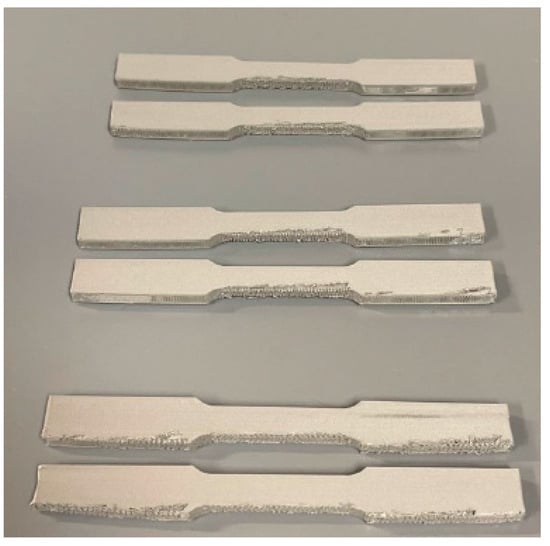
Figure 1
Open AccessReview
Influence of Dressing Methods on Chipping Size During Si and SiC Die Singulation: A Review
by
Sergey N. Grigoriev, Anna A. Okunkova, Marina A. Volosova, Khaled Hamdy and Alexander S. Metel
J. Manuf. Mater. Process. 2025, 9(12), 405; https://doi.org/10.3390/jmmp9120405 - 9 Dec 2025
Abstract
The review is intended to systematize the latest achievements and the most promising methods in polycrystalline diamond saw blade dressing used for dicing Si and SiC wafers. Dicing, or die singulation, is important in IC assembly, and the quality of the die edges
[...] Read more.
The review is intended to systematize the latest achievements and the most promising methods in polycrystalline diamond saw blade dressing used for dicing Si and SiC wafers. Dicing, or die singulation, is important in IC assembly, and the quality of the die edges influences the final product quality. Reducing chipping size and width has been a scientific problem over the last few decades. Many techniques were proposed to solve it. The most practical solutions involved optimizing processing factors and cutting direction in accordance with the crystallographic structure of the wafers, since silicon and silicon carbide are hard and brittle materials with low fracture toughness, high hardness, and high thermal conductivity. Wear of the PCD saw blade is also a contributing factor to the formation of chipping and cracks. Dressing allows the bond material removal and diamond grain liberation, where grit size plays a critical role. Dressing techniques were divided into two groups depending on the nature of the exposure, and a combined technique of dressing–coating–redressing was also observed. The less significant chipping size effect was observed for the combined technique in dicing Si wafers when the effect of the techniques based on the mechanical and electrophysical exposures was more significant.
Full article
(This article belongs to the Special Issue Advances in Machining Processes of Difficult-to-Machine Materials)
►▼
Show Figures

Figure 1
Open AccessArticle
Process Optimization, Microstructure and Mechanical Properties of SiC + TiB2/AlSi10Mg Composites Fabricated by Laser-Directed Energy Deposition
by
Xin Zhang, Siyu Zhang, Yijie Peng, Long Geng, Chennuo Kang, Zhe Feng, Wei Fan, Hua Tan and Xin Lin
J. Manuf. Mater. Process. 2025, 9(12), 404; https://doi.org/10.3390/jmmp9120404 - 8 Dec 2025
Abstract
►▼
Show Figures
In this study, TiB2/AlSi10Mg, 2 wt.% SiC + TiB2/AlSi10Mg, and 5 wt.% SiC + TiB2/AlSi10Mg composite powders were prepared via high-energy ball milling. For the first time, TiB2 and SiC hybrid particle-reinforced aluminum matrix composites (AMCs)
[...] Read more.
In this study, TiB2/AlSi10Mg, 2 wt.% SiC + TiB2/AlSi10Mg, and 5 wt.% SiC + TiB2/AlSi10Mg composite powders were prepared via high-energy ball milling. For the first time, TiB2 and SiC hybrid particle-reinforced aluminum matrix composites (AMCs) were fabricated using the Laser-Directed Energy Deposition (LDED) technique. The effects of processing parameters on the microstructure evolution and mechanical properties were systematically investigated. Using areal energy density as the main variable, the experiments combined microstructural characterization and mechanical testing to elucidate the underlying strengthening and failure mechanisms. The results indicate that both 2 wt.% and 5 wt.% SiC + TiB2/AlSi10Mg composites exhibit excellent formability, achieving a relative density of 98.9%. However, the addition of 5 wt.% SiC leads to the formation of brittle Al4C3 and TiC phases within the matrix. Compared with the LDED-fabricated AlSi10Mg alloy, the tensile strength of the TiB2/AlSi10Mg composite increased by 21.4%. In contrast, the tensile strengths of the 2 wt.% and 5 wt.% SiC + TiB2/AlSi10Mg composites decreased by 3.7% and 2.6%, respectively, mainly due to SiC particle agglomeration and the consumption of TiB2 particles caused by TiC formation. Nevertheless, their elastic moduli were enhanced by 9% and 16.3%, respectively. Fracture analysis revealed that the composites predominantly exhibited ductile fracture characteristics. However, pores larger than 10 μm and SiC/TiB2 clusters acted as crack initiation sites, inducing stress concentration and promoting the propagation of secondary cracks.
Full article

Figure 1
Open AccessArticle
Precipitation, Deformation, and Superplastic Behavior of Novel Crossover Al-Zn-Mg-Cu-Y(Er)-Zr-Cr-Ti-Fe-Si Alloys
by
Maria V. Glavatskikh, Ruslan Yu. Barkov, Maxim G. Khomutov, Olga A. Yakovtseva and Andrey V. Pozdniakov
J. Manuf. Mater. Process. 2025, 9(12), 403; https://doi.org/10.3390/jmmp9120403 - 7 Dec 2025
Abstract
This research focuses on the investigation of microstructure, deformation, and superplastic behavior in wide range of strain rates of novel crossover Al-Zn-Mg-Cu alloy with Y/Er. The precipitation and superplastic behavior of the Al-Zn-Mg-Cu-Zr-Cr-Ti with Er/Y and Fe/Si impurities alloys have been studied. The
[...] Read more.
This research focuses on the investigation of microstructure, deformation, and superplastic behavior in wide range of strain rates of novel crossover Al-Zn-Mg-Cu alloy with Y/Er. The precipitation and superplastic behavior of the Al-Zn-Mg-Cu-Zr-Cr-Ti with Er/Y and Fe/Si impurities alloys have been studied. The microstructure of the alloys with nano-sized precipitates and micron-sized particles allows obtaining a micrograin stable microstructure. The spherical D023-Al3(Er,Zr) precipitates with a diameter of about 20 nm and rod-like crystalline and qusicrystalline E (Al18Mg3Cr2) precipitates with a thickness of about 20 nm and length of about 150–200 nm were identified by transmission electron microscopy. The superplastic deformation behaviors were investigated under different temperatures of 460–520 °C and different strain rates of 3 × 10−4 to 3 × 10−3 s−1. The microstructure observation shows that uniform and equiaxed grains can be obtained by dynamic recrystallization before superplastic deformation. The alloy with Y exhibits inferior superplastic properties, while the alloy with Er has an elongation of more than 350% at a rate of 1 × 10−3 s−1 and a temperature of 510 °C.
Full article
(This article belongs to the Special Issue Deformation and Mechanical Behavior of Metals and Alloys)
►▼
Show Figures

Figure 1
Open AccessArticle
Technological Assurance of Surface Roughness of Ti-6Al-4V Parts Made Using Additive and Conventional Manufacturing Methods
by
Artis Kromanis, Arturs Vevers, Gatis Muiznieks, Jyothi Prasad Gandreddi and Arturs Korenkovs
J. Manuf. Mater. Process. 2025, 9(12), 402; https://doi.org/10.3390/jmmp9120402 - 5 Dec 2025
Abstract
►▼
Show Figures
Additive manufacturing (AM) is finding increasing application in engineering, especially in manufacturing. As a result, new designs and machines not previously possible due to the restrictions of conventional manufacturing methods may be made. Nevertheless, the same AM parts require post-processing using conventional machining
[...] Read more.
Additive manufacturing (AM) is finding increasing application in engineering, especially in manufacturing. As a result, new designs and machines not previously possible due to the restrictions of conventional manufacturing methods may be made. Nevertheless, the same AM parts require post-processing using conventional machining methods such as turning which is the subject of this study. This study provides a comparative analysis of the technological assurance of Ti-6Al-4V parts made via AM using selective laser melting (SLM) and conventional manufacturing methods. The effects of machining parameters such as cutting speed, depth of cut, and feed on the surface roughness of machined Ti-6Al-4V parts are studied. The study concluded that at low feed (0.12 mm/rev.) and low and average depth of cut (0.3 mm and 0.5 mm), the best surface roughness was obtained on the 3D printed samples rather than on the samples obtained using the conventional manufacturing method. In addition, an alternative surface roughness measurement scheme is proposed, which not only allows for measuring the surface roughness, including multiple aspects, but also for identifying possible surface defects in AM parts.
Full article
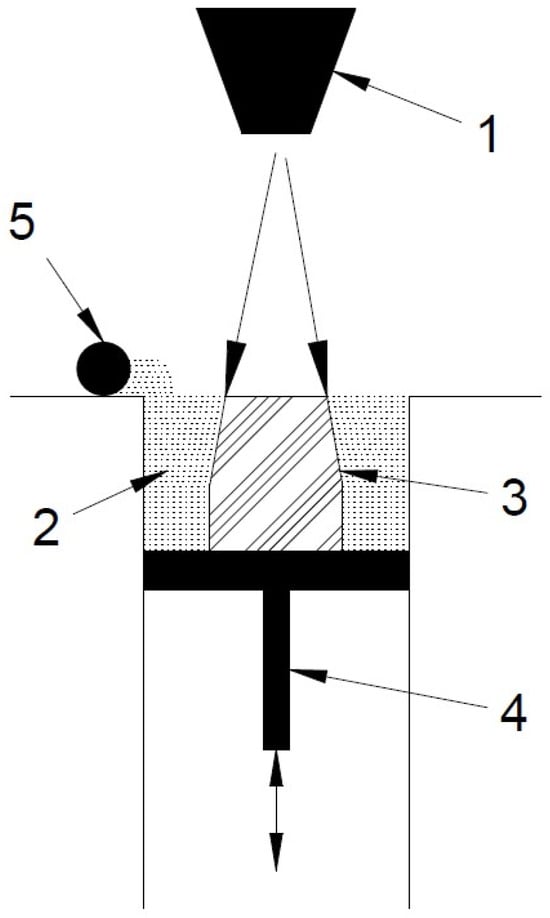
Figure 1
Open AccessReview
Processing and Development of Porous Titanium for Biomedical Applications: A Comprehensive Review
by
Mayank Kumar Yadav, Akshay Yarlapati, Yarlapati Naga Aditya, Praveenkumar Kesavan, Vaibhav Pandey, Chandra Shekhar Perugu, Amit Nain, Kaushik Chatterjee, Satyam Suwas, Jayaraj Jayamani and Prashanth Konda Gokuldoss
J. Manuf. Mater. Process. 2025, 9(12), 401; https://doi.org/10.3390/jmmp9120401 - 4 Dec 2025
Abstract
►▼
Show Figures
Titanium (Ti) and its alloys are widely used in orthopedic applications, including total hip and knee replacements, bone plates, and dental implants, because of their superior biocompatibility, bioactivity, corrosion resistance, and mechanical robustness. These alloys effectively overcome several limitations of conventional metallic implants,
[...] Read more.
Titanium (Ti) and its alloys are widely used in orthopedic applications, including total hip and knee replacements, bone plates, and dental implants, because of their superior biocompatibility, bioactivity, corrosion resistance, and mechanical robustness. These alloys effectively overcome several limitations of conventional metallic implants, such as 316L stainless steel and Co-Cr alloys, particularly with respect to corrosion, fatigue performance, and biological response. However, dense Ti alloys possess a relatively high elastic modulus, which can cause stress shielding in load-bearing applications. This challenge has motivated significant research toward engineered porous Ti structures that exhibit a reduced and bone-matched modulus while preserving adequate mechanical integrity. This review provides a comprehensive examination of powder metallurgy and additive manufacturing approaches used to fabricate porous Ti and Ti-alloy scaffolds, including additive manufacturing and different powder metallurgy techniques. Processing routes are compared in terms of achievable porosity, pore size distribution, microstructural evolution, mechanical properties, and biological outcomes, with emphasis on the relationship between processing parameters, pore architecture, and functional performance. The reported findings indicate that optimized powder-metallurgy techniques can generate interconnected pores in the 100–500 μm range suitable for osseointegration while maintaining compressive strengths of 50–300 MPa, whereas additive manufacturing enables the precise control of hierarchical architectures but requires careful post-processing to remove adhered powder, stabilize microstructures, and ensure corrosion and wear resistance. In addition, this review integrates fundamental aspects of bone biology and bone implant interaction to contextualize the functional requirements of porous Ti scaffolds.
Full article

Graphical abstract
Open AccessArticle
A Bidirectional Digital Twin System for Adaptive Manufacturing
by
Klaas Maximilian Heide, Berend Denkena and Martin Winkler
J. Manuf. Mater. Process. 2025, 9(12), 400; https://doi.org/10.3390/jmmp9120400 - 4 Dec 2025
Abstract
Digital Twin Systems (DTSs) are increasingly recognized as enablers of data-driven manufacturing, yet many implementations remain limited to monitoring or visualization without closed-loop control. This study presents a fully integrated DTS for CNC milling that emphasizes real-time bidirectional coupling between a real machine
[...] Read more.
Digital Twin Systems (DTSs) are increasingly recognized as enablers of data-driven manufacturing, yet many implementations remain limited to monitoring or visualization without closed-loop control. This study presents a fully integrated DTS for CNC milling that emphasizes real-time bidirectional coupling between a real machine and a virtual counterpart as well as the use of machine-native signals. The architecture comprises a physical space defined by a five-axis machining center, a virtual space implemented via a dexel-based technological simulation environment, and a digital thread for continuous data exchange between those. A full-factorial simulation study investigated the influence of dexel density and cycle time on engagement accuracy and runtime, yielding an optimal configuration that minimizes discretization errors while maintaining real-time feasibility. Latency measurements confirmed a mean response time of 34.2 ms, supporting process-parallel decision-making. Two application scenarios in orthopedic implant milling validated the DTS: process force monitoring enabled an automatic machine halt within 28 ms of anomaly detection, while adaptive feed rate control reduced predicted form error by 20 µm. These findings demonstrate that the DTS extends beyond passive monitoring by actively intervening in machining processes; enhancing process reliability and part quality; and establishing a foundation for scalable, interpretable digital twins in regulated manufacturing.
Full article
(This article belongs to the Special Issue Digital Twinning for Manufacturing)
►▼
Show Figures

Graphical abstract
Open AccessArticle
Turn Milling of Inconel 718 Produced via Additive Manufacturing Using HVOF and DMLS Methods
by
Michal Povolný, Michal Straka, Miroslav Gombár, Jan Hnátík, Jan Kutlwašer, Josef Sklenička and Jaroslava Fulemová
J. Manuf. Mater. Process. 2025, 9(12), 399; https://doi.org/10.3390/jmmp9120399 - 4 Dec 2025
Abstract
Additive and coating technologies, such as high-velocity oxy-fuel (HVOF) thermal spraying and direct metal laser sintering (DMLS), often require extensive post-processing to meet dimensional and surface quality requirements, which remains challenging for nickel-based superalloys such as Inconel 718. This study presents the design
[...] Read more.
Additive and coating technologies, such as high-velocity oxy-fuel (HVOF) thermal spraying and direct metal laser sintering (DMLS), often require extensive post-processing to meet dimensional and surface quality requirements, which remains challenging for nickel-based superalloys such as Inconel 718. This study presents the design and topology optimisation of a cutting tool with a linear cutting edge, capable of operating in turn-milling or turning modes, offering a viable alternative to conventional grinding. A non-optimised tool served as a baseline for comparison with a topology-optimised variant improving cutting-force distribution and stiffness-to-mass ratio. Finite element analyses and experimental turn-milling trials were performed on DMLS and HVOF Inconel 718 using carbide and CBN inserts. The optimised tool achieved significantly reduced roughness values: for DMLS, Ra decreased from 0.514 ± 0.069 µm to 0.351 ± 0.047 µm, and for HVOF from 0.606 ± 0.069 µm to 0.407 ± 0.069 µm. Rz was similarly improved, decreasing from 4.234 ± 0.343 µm to 3.340 ± 0.439 µm (DMLS) and from 5.349 ± 0.552 µm to 4.521 ± 0.650 µm (HVOF). The lowest measured Ra, 0.146 ± 0.030 µm, was obtained using CBN inserts at the highest tested cutting speed. All improvements were statistically significant (p < 0.005). No measurable tool wear was observed due to the small engagement and the use of a fresh cutting edge for each pass. The resulting surface quality was comparable to grinding and clearly superior to conventional turning. These findings demonstrate that combining topology optimisation with a linear-edge tool provides a practical and efficient finishing approach for additively manufactured and thermally sprayed Inconel 718 components.
Full article
(This article belongs to the Special Issue Advanced Design, Manufacturing, and Applications of Precision Machine Tools)
►▼
Show Figures

Figure 1
Highly Accessed Articles
Latest Books
E-Mail Alert
News
Topics
Topic in
Energies, JMMP, Materials, Metals
Advanced Processes in Metallurgical Technologies, 2nd Volume
Topic Editors: Mariola Saternus, Ladislav SochaDeadline: 31 December 2025
Topic in
Coatings, JMMP, Lubricants, Machines, Materials
Advanced Manufacturing and Surface Technology, 2nd Edition
Topic Editors: Dingding Xiang, Kaiming Wang, Xudong SuiDeadline: 20 March 2026
Topic in
Aerospace, Applied Sciences, Astronautics, Coatings, J. Compos. Sci., JMMP, Materials, Polymers
Advanced Materials and Manufacturing for Extreme Environments in Energy and Aerospace
Topic Editors: Richard E. Wirz, Chih-Hung (Alex) Chang, Tianyi Chen, Somayeh Pasebani, Dong Lin, Devin J. Roach, Jesse A. RodriguezDeadline: 31 March 2026
Topic in
Actuators, Algorithms, BDCC, Future Internet, JMMP, Machines, Robotics, Systems
Smart Product Design and Manufacturing on Industrial Internet
Topic Editors: Pingyu Jiang, Jihong Liu, Ying Liu, Jihong YanDeadline: 30 June 2026

Conferences
Special Issues
Special Issue in
JMMP
Innovative and Sustainable Advances in Polymer Composites for Additive Manufacturing: Processing, Microstructure, Machining, and Mechanical Properties
Guest Editor: Mohd Shahneel SaharudinDeadline: 30 December 2025
Special Issue in
JMMP
Advances in Injection Molding: Process, Materials and Applications, 2nd Edition
Guest Editors: Rossella Surace, Vincenzo Bellantone, Irene FassiDeadline: 31 December 2025
Special Issue in
JMMP
Haptic-Robotic Systems in Industrial Design, Manufacturing, Assembly, Simulation, and Training
Guest Editors: António Lopes, Adriano A. Santos, Filipe PereiraDeadline: 31 December 2025
Special Issue in
JMMP
Advances in Micro Machining Technology
Guest Editors: Hansong Ji, Chaojiang Li, Munish Kumar GuptaDeadline: 31 December 2025



